WWW NOTE: One Photoshop file is included in the Mac distribution. 97K total.
Note: To see this file correctly requires Word 5.0 with Times Roman font at 12, 18 and 24 points. To see the imbedded sample pictures be sure to turn off "Use picture placeholders" under Edit (or "Commands...")
IMPORTANT: Set the screen to "256 Greys" in Monitors or Switcheroo. Not "256 Colors" (Word then uses the System color table, which has only 16 greys and renders the sample pictures severely banded!)
Requirements: Photoshop, should work with any version, menu descriptions are for V2.0
Screen: This works down to 8 bit monochrome
Author: Kai Krause, Curved Space*Design, Malibu [...] For comments, questions, further variations there is a corresponding folder on Compuserve in the Graphics area: Go Graphics>Graphics B Vendor+ forum>HSC or Go KPT.
#7c Displace Filter Examples
There is a basic file in this folder explaining details of the Displacement Map process. Please read it first.
Following is only a short description of a particular filter, (which is part of this archive and can be applied to any image)
KPT Displace.Glassy Spheroid
fig 1a) 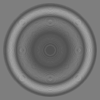
The horizontal offset is controlled by channel #1
The grey outside corners will not affect the image at all, while the concentric circles will displace in a controlled fashion, darker to the right, lighter to the left.
fig 1b) 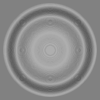
The vertical offset is controlled by channel #2
The vertical component is symmetrical to the horizontal. You can modify this with "Levels.." too.
fig 2) 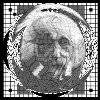
The combined effect at a scale setting of 33 / 33 shows the glassy spheroid effect . In the Displacement map the concentric circles create an overall twirl to suggest the sphere, while the gray center portions leave portions of the original image, slightly warbled as if diffracted by glass.
fig 3 a)  fig 3 b)
fig 3 b) 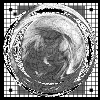
At 3/3 the circular ripple effect is beginning to be visible (In this case the test image has a circle accentuating the effect...) while at 66/66 the sphere is quite complete with the center image still roughly indentifiable. The advantage over a simple Spherize filter is in the details, the typical non-linear distortions, reflections and refractions that make this potentially much more realistic. The way the face gets contorted, the nose bent and squashed is quite unlike the other filters, which are very `clean'.
In fact, while the straight application of this Displacement map may be somewhat harsh, it is very useful in supplying raw information to be combined with other general techniques. The Instant Sphere document found in this forum (KPT #5) combined with channel operations can yield even more realistic spheroid and glassy effects such as seen in fig 4) below. I may include a complex example image in the future.
fig 4) 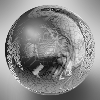
Note: The image being displaced here is 200x200 pixels. If your image is larger you have to increase the Scale variables accordingly. Read the main Displace document for further details.
Discover, Displace, Describe the results in the KPT folder..... thanks, Kai Krause
By Matthias Müller-Prove. Modified:
5/1/20

